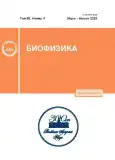SARS-Cov-2 pandemic as a “predator-prey” model: biophysical, social and heliophysical factors of the spread of local epidemics
- Authors: Ragulskaya M.V1
-
Affiliations:
- Pushkov Institute of Terrestrial Magnetism, Ionosphere and Radio Wave Propagation, Russian Academy of Sciences
- Issue: Vol 68, No 4 (2023)
- Pages: 780-788
- Section: Articles
- URL: https://journals.rcsi.science/0006-3029/article/view/142133
- DOI: https://doi.org/10.31857/S0006302923040191
- EDN: https://elibrary.ru/KNJSGK
- ID: 142133
Cite item
Full Text
Abstract
This paper considers the peculiarities of the spread of the coronavirus pandemic in different countries within a “predator-prey” model under the influence of external modulation of solar activity. This paper presents a discussion focusing on the genetic composition of the population that turned out to be the main factor in differentiation of the dynamics underlying local transmissions of SARS-CoV-2 spreading under the influence of the global minimum of solar activity. In countries where relative mortality due to coronavirus is the highest, there is a tendency of dominance of haplogroup R1b among the population. It was shown that the dynamics of morbidity and mortality in countries the populations of which are genetically similar, irrespective of the introduction or absence of COVID-19 lockdowns on their areas, are the same. As the first wave of the pandemic progressed, the emergence of self-oscillatory waves in small countries with a hard lockdown was revealed leading to a significant increase in the number of victims in subsequent waves. This paper discusses the results of universal vaccination in countries with haplogroup R1b after which the level of relative mortality lowered by 5-8 times. However, in countries with haplogroup N and R1a + N, by mid-2022, relative mortality increased by 2-4 times compared to 2020.
About the authors
M. V Ragulskaya
Pushkov Institute of Terrestrial Magnetism, Ionosphere and Radio Wave Propagation, Russian Academy of Sciences
Author for correspondence.
Email: ra_mary@mail.ru
Troitsk, Moscow, Russia
References
- M. Ragulskaya, J. Nov. Physiother. Phys. Rehabil., 7 (1), 031 (2020).
- D. Atri and A. Melot, Astroparticle Physics, 53, 186 (2012).
- V. Obridko, M. Ragulskaya, and E. Khramova, J. Atmospher. Solar-Terrestr. Physics, 208, 105395 (2020).
- N. Belisheva, H. Lammer, H. Biernat, and E. Vashenuyk, Trans. Astrophys. Space Sci., 8, 7 (2012).
- M. V. Ragulskaya, V. N. Obridko, and E. G. Khramova, Biophysics, 65 (4), 686 (2020).
- V. Obridko and Yu. Nagovitsyn, Solar activity, cyclicity and forecasting methods (VVM, Saint-Petersburg, 2017).
- M. M. Katsova, B. A. Nizamov, A. A. Shlyapnikov, Geomagnetism and Aeronomy, 62 (7), 903 (2022).
- M. Gudel, Living Rev. Solar Phys., 4 (3), 137 (2007).
- E. Gromozova, et al., Sun and Geosphere, 7 (2), 117 (2012).
- M. H. Nasirpour, A. Sharifi, M. Ahmadi, and S. J. Ghoushchi, Environ. Sci. Pollut. Res., 28, 38074 (2021).
- M. Ragulskaya, Open Astronomy, 30 (1), 149 (2021).
- A. Nguyen, et al., J. Virol. 94 (13), e00510 (2020).
- Y. Souilmi, et al., Curr. Biol., 31 (16), 3504 (2021).
- V. Ishkov, Space Research, 55 (6), 391 (2017).
Supplementary files










